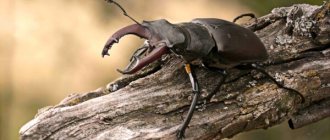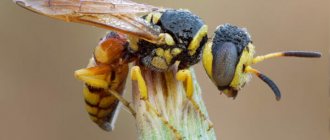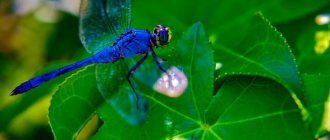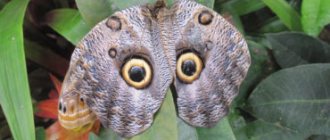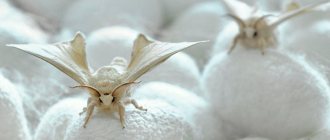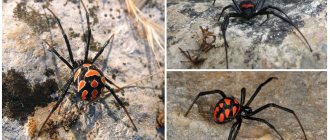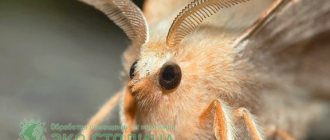Origin of the name praying mantis
The academic name for the praying mantis was given back in 1758 by the great Swedish naturalist Karl Liney, who drew attention to the fact that the pose of a praying mantis in ambush and guarding its prey is very similar to the pose of a man folding his hands in prayer to God. Because of such striking similarity, the scientist gave the insect the Latin name “Mantis religiosa”, which literally translates as “religious priest”; the name “mantis” itself came into our language.
Although it is not called this way everywhere, our hero also has other, not so blissful names, for example, in Spain he is called Caballito del Diablo - the devil's horse or simply - muerte - death. Such creepy names are obviously associated with the equally creepy habits of praying mantises.
What are the types
There are 12 subspecies in the common praying mantis family. There are some truly amazing creatures among them. The African Ischnomantis gigas is included in the Guinness Book of Records as the largest insect in the world. The orchid mantis is considered the most beautiful among the families; the photo of Hymenopus coronatus can easily be confused with a flower. Delicate pearlescent color with purple tints looks like a bud.
Orchid mantis
The Asian species is recognized as the most aggressive. The bite of this species can even pierce human skin. In the insect kingdom, the praying mantis is recognized as a master of camouflage; a photo of the insect confirms this. The flower mantis Idolomantis diabolica imitates fallen leaves and petals. Its color changes depending on the surrounding gamut. The second largest in the world, Deroplatys desiccata, not only acquires the color of the leaves, but also the body structure repeats the silhouettes of plants.
Flower mantis
The orchid mantis has similar properties. The body of Pseudocreobotra wahlbergii is colored in lilac and violet tones. The thorns give it a petal-like appearance. You can admire what Choeradodis rhombicollis looks like. The Peruvian shieldbearer is covered with plates that are indistinguishable in appearance from large leaves.
Mantis religios Pogonogaster tristani looks like a tussock of moss. The entire body is covered with small villi, creating a moss texture. It is difficult to get photos of praying mantises because they skillfully hide their presence. The thistle mantis insect Blepharopsis mendica has transformed its body into the appearance of a dry plant leaf.
Mantis religion
Lifespan
The question of how long a praying mantis lives was answered by the French naturalist Roger Caillois. In his work “Essay on the Mantis,” he described the life cycle of the insect. Answered the question why mantises bite off their partner's head. I found out whether the praying mantis bites on contact with a person or animal. The main achievement of the researcher was to determine the exact lifespan in the wild, which ranged from 1 to 2 months.
What a praying mantis looks like: structure and characteristics
The structure of the praying mantis is characterized by an elongated body, which distinguishes it from other arthropod insects.
The praying mantis is perhaps the only living creature that can easily turn its triangular-shaped head a full 360 degrees. Thanks to such a useful skill, he can see an enemy approaching from behind. He also has only one ear, but despite this, he has excellent hearing.
The eyes of the praying mantis have a complex faceted structure, located on the sides of the head, but in addition to them, our hero has three more simple eyes above the base of the antennae.
The antennae of mantises are comb-like, feathery or filamentous, depending on the species of the insect.
Mantises, almost all of their species, have well-developed wings, but mainly only males can fly; females, due to their greater weight and size, find it more difficult to fly than males. The wings of praying mantises consist of two pairs: front and rear, the front ones serve as a kind of elytra that protect the hind wings. Also, praying mantis wings usually have bright colors, and sometimes they even have peculiar patterns. But among the many varieties of mantises, there is a kind of earthen mantis (Latin name Geomantis larvoides), which has no wings at all.
Earth mantis.
Mantises have well-developed forelimbs, which have a rather complex structure - each of them consists of many parts: trochanters, femurs, tibiae and tarsi. The bottom of the thigh has large sharp spines arranged in three rows. There are also spines (though smaller ones) on the mantis’s shin, which is decorated with a sharp, needle-like hook at the end. See the picture for an indicative structure of a praying mantis’ foot.
Mantises hold their prey just between the thigh and the lower leg until their meal is over.
The blood circulation of mantises is primitive, but there is a reason for this - an unusual respiratory system.
The oxygen mantis is equipped with a complex system of tracheae connected to dichals (stigmas) on the abdomen in the middle and posterior part of the body. The trachea contains air sacs that enhance ventilation throughout the respiratory system.
Appearance and varieties
Insects have a long body with a special structure. This is worth talking about in a message or report about the praying mantis. The triangular head can rotate around its axis. There are two compound eyes on its sides, and three more are located at the base of the antennae. The mouthparts of the gnawing type allow you to quickly deal with victims.
The body of the praying mantis consists of ten sections. On the last segment, paired appendages grow, which can be considered olfactory organs. The forelimbs are covered with spines, allowing them to hold prey. Predators have two pairs of well-developed wings with which they can fly. In nature, there are several types of mantises:
- ordinary;
- Chinese;
- spike-eyed;
- orchidaceous;
- Indian.
The common mantis is considered the most common species. It is green or brown in color with a dark round spot near the front legs. The Chinese insect has a similar color, but the mantis itself is much larger. Its body grows up to 15 cm in length. Spike-eyed is an African predator that can change color to suit its environment. Orchid is very beautiful, similar to the flower of the same name. But this is a small species - the male grows only up to 4 mm. The Indian flower is an insect with a bright body and an eye-shaped spot on its limbs.
Sizes of praying mantises
We have already mentioned above that female praying mantises are much larger than males, oddly enough, this is where their main sexual difference manifests itself.
A species of praying mantis, called Ischnomantis gigas in Latin and living in Africa, can reach 17 cm in length; perhaps this representative of the praying mantis kingdom is a real record holder in size.
Ischnomantis gigas is the largest praying mantis in the world.
It is slightly inferior to Heterochaeta orientalis or Heterochaeta eastern, it reaches 16 cm in length. Ordinary mantises are much smaller in size, on average no more than 0.5-1.5 cm in length.
How long does a praying mantis live?
Each species has its own life expectancy. It can vary from 2 to 11 months.
Keeping mantises in captivity increases life expectancy to 1.5 years.
What does a praying mantis eat?
It is no secret that our hero is a notorious predator who loves to feed on both smaller insects and is not afraid to attack larger prey even than himself. Flies eat them,
mosquitoes, bees, wasps, bumblebees, butterflies, beetles, etc. Large representatives of the praying mantis family (see above) can even attack small rodents, birds and small amphibians: frogs, lizards.
Mantises usually attack from an ambush, unexpectedly grab the prey with their front paws and do not let go until they have completely eaten it. Strong jaws allow these gluttons to eat even relatively large prey.
Coloring
You are probably familiar with the common praying mantis from your school biology textbooks. Its color type is very variable, ranging from yellow or green to dark brown or brownish-gray. Usually it corresponds to the habitat and matches the color of the grass, stones and leaves.
The most common color is green or white-yellow. Older individuals have a paler outfit. Dark brown spots appear on the body with age. This is explained by the fact that the body stops producing amino acids important for life: methionine, leucine, tryptophan, etc. In laboratory conditions, when these substances are added to food, the life of the insect almost doubles - up to four months. This is the maximum period that an ordinary praying mantis can live.
Enemies of Mantises
Although praying mantises are excellent predator hunters, they themselves can also become prey for snakes, some birds or bats. But the main enemies of mantises, perhaps, are their own relatives - other mantises. Fights to the death between two rival mantises are not uncommon. The fights themselves, both between praying mantises and with other insects, are very spectacular; first of all, the praying mantis seeks to scare its opponent, for this it takes a special frightening pose - it throws its front paws forward and lifts its belly up. All this may be accompanied by corresponding threatening sounds. Such a demonstration of strength is by no means feigned; mantises are desperately brave and bravely rush even at a much larger opponent. Thanks to such courage and bravery, mantises often emerge victorious from such fights.
Natural enemies
Mantises are dangerous predators, but they have many natural enemies. They are eaten by birds, rodents, reptiles, and they also become victims of their own relatives. Under natural conditions, fights occur between them. There will definitely be a winner who will eat the loser. Most mantises die due to the fault of members of their own species, and not from rodents and birds.
They use their own color as a means of protection. It allows you to camouflage among trees and foliage. Insects practically merge with their environment; the Chinese species resembles flower buds. Only twitching antennae and a moving head can give them away. In most cases, enemies do not find mantises because they do not have sharp vision.
The population of praying mantises is gradually declining, which is facilitated by human activity. People cut down forests and plow up fields where insects prefer to live. Some species of predators are listed in the Red Book, as they are on the verge of extinction. There are known situations when some praying mantises expel others from their places.
Insects reproduce slowly in cold regions, because here they may not produce offspring for 6 months. The warm climate contributes to an increase in population.
Where does the praying mantis live?
Almost everywhere, since their habitat is very wide: Central and Southern Europe, Asia, North and South America, Africa, Australia. They are only absent in the northern regions, since mantises are not very accustomed to the cold. But they are perfectly suited, for example, to the hot and humid climate of tropical Africa and South America. Praying mantises thrive in tropical forests, steppe regions, and rocky deserts.
They rarely move from place to place, preferring their usual habitat to unknown distant places, the only reason that can prompt them to travel is the lack of food supply.
Mantis coloring
The color of these insects depends on the conditions in which they live. Thus, mantises living among greenery are green in color, while those living on the ground are brown.
Thanks to their camouflage color, they can sit in ambush for a long time, waiting for their prey and attacking unnoticed. They rarely leave their habitats, only in cases of lack of food.
Types of mantises: photos and names
Scientists have counted about 2000 different species of mantises; unfortunately, we will not be able to list them all in our article, but we will describe, in our opinion, the most interesting representatives.
Common praying mantis
The common praying mantis lives in most countries of Europe, Asia, and Africa. The common praying mantis is a very large representative of the praying mantis kingdom, reaching up to 7 cm (female) and 6 cm (male). As a rule, they are green or brown in color, the wings are well developed, at least, flying from branch to branch is not a problem for the common mantis. The abdomen is ovoid. This type of mantis can be distinguished by a black spot, which is located on the coxae of the front pair of legs on the inside.
Chinese mantis
Obviously, the homeland and main habitat of this type of mantis is China. The Chinese mantis is quite large, females reach up to 15 cm in length, but the size of males is much more modest. They have green and brown colors. A characteristic feature of Chinese mantises is their nocturnal lifestyle, while their other relatives still sleep at night. Also, young individuals of Chinese mantises do not have wings, which grow only after several molts, and then they acquire the ability to fly.
Praying mantis Creobroter meleagris
The praying mantis Creobroter meleagris lives in southwest Asia: India, Vietnam, Cambodia and several other countries. Usually reach 5 cm in length. The colors are white and cream. You can recognize them by the light brown stripes that run along the entire body and head. Also on the wings they have one small and one large spot of white or cream color.
Indian flower mantis
The mantis Creobroter gemmatus especially loves the humid forests of southern India, Vietnam and other Asian countries. This species is small, females grow to only 40 mm, males up to 38 mm. The body is more elongated than that of other relatives. And for additional protection, the Indian praying mantis has special spikes of different heights on its hips. Painted in cream colors. Representatives of this species are excellent flyers, both males and females, due to their low weight, and both pairs of wings are well developed. Interestingly, on the front wings they have a spot similar to an eye with two pupils, which scares away predators. Flower mantises live, as their names suggest, in plant flowers, where they guard their prey.
Spiny flower mantis
The same mantis Pseudocreobotra wahlbergii lives in the countries of southern and eastern Africa. In terms of lifestyle and size, it is very similar to the Indian flower mantis. But what is especially interesting is its coloring - it is truly artistic; on the upper pair of wings there is an interesting pattern reminiscent of a spiral or even an eye. The abdomen of this species has additional spines, which give it its name.
Orchid mantis
The orchid mantis is, in our opinion, the most beautiful representative of the mantis world. It also received its name for a reason, namely for its external resemblance to beautiful orchids, on which it actually hides in ambush, waiting for its next victim. Female orchid mantises are exactly twice as large as males: 80 mm versus 40. And orchid mantises, even among other mantises, are distinguished by amazing courage; representatives of this species are not afraid to attack even insects twice their size.
Heterochaete eastern
The oriental heterochaete, or spiny-eyed mantis, is one of the largest mantises in the world (the female reaches 15 cm in length) and lives throughout most of Africa. These mantises live in the branches of bushes; fortunately, their appearance also resembles twigs.
Reproduction and lifespan
Mating of praying mantises ends with the females laying several dozen or hundreds of eggs in specially constructed protein bags, which depends on the type of insect.
All this happens quite interestingly. The cameras are located on the tree. The female lays one egg in each cell. Time passes and the protein bags freeze, protecting the eggs inside them from external factors and enemies.
There is only one hole in this structure; it is through it that insect larvae are selected. Outwardly, they are very similar to adults, only they do not have wings. These amazing animals live for about six months.
Reproduction of praying mantises
And here we move on to the most interesting part, namely the reproduction of mantises, which, as a rule, has a sad and tragic end for the males. But let's not get ahead of ourselves, but start in order. With the onset of the mating season (usually in the fall), male praying mantises, using their organs of charm, begin searching for females ready to mate. Having found one, he performs a special “mating dance” in front of her, which elevates him to the rank of sexual partner. Then the mating process itself begins, during which the female praying mantis has the bad habit of biting off her male’s head and then completely eating him. Some scientists believe that this behavior, which is more than creepy in our opinion, also has its own biological reasons - having eaten her “groom”, the female in this simple way replenishes the reserves of nutritious protein substances necessary for future offspring.
Mantis mating
Although it also happens that the male manages to get away from his “beloved” in time, thereby avoiding the sad fate of food.
After some time, the fertilized female lays eggs, simultaneously enveloping them with a special sticky secretion, which is secreted by their special glands. This secretion serves as a kind of protective capsule for the eggs of future mantises and is called an ooteca. The fertility of a female depends on its species; usually a female is capable of laying from 10 to 400 eggs at a time.
Praying mantis larvae stay in the eggs from three weeks to six months, after which they crawl out of the eggs. Further, their development proceeds at a fairly fast pace and after about 4-8 molts the larva degenerates into an adult mantis.
Insect Reproduction
In a brief description of the praying mantis insect for children, you can talk about how these creatures reproduce . They have a short life - from two months to a year. Only in artificial conditions can they survive for up to two years. A few weeks after birth, young individuals are able to reproduce. The female manages to mate twice in her entire life, but males do not always survive even one period. Insects begin to actively flirt with each other in August, and the dancing continues until autumn. But in hot climates, the mating season can last all year round.
When a male wants to reproduce, he lures the female with mating dances and also secretes a sticky secretion. Based on the special aroma, the partner identifies the insect as a representative of her species and does not attack. Mating lasts eight hours. In the end, not every male survives, as many end up eaten by the hungry female.
At one time, the expectant mother lays 100-300 eggs, placing them on tree bark or on the back of leaves. During this process, they secrete a specific secretion, which hardens over time. This way the eggs are covered with a dense cocoon that protects them from external influences.
The higher the air temperature, the faster the young animals develop. This period can take from several weeks to 6 months. The eggs then hatch into larvae, but they look nothing like adult mantises. During adolescence, they experience four molts and only after these molts they resemble adult mantises. Almost immediately after hatching, the larvae begin to eat mosquitoes and small flies.
Keeping praying mantises at home
Terrarium
It would be a very exotic and unusual act to get yourself a pet praying mantis, wouldn’t it? However, there are people who have such “pets” and if you also want to join them, then the first thing you will have to take care of is the terrarium. A relatively small glass or plastic terrarium with a mesh lid is suitable; its dimensions should be at least three times the size of the mantis itself. Inside it would be nice to place twigs or small plants on which the praying mantis will climb like trees.
Temperature
Praying mantises are heat-loving insects, so the optimal temperature for them will be from +23 to +30 C. You can use special heaters for terrariums.
Humidity
Also, do not forget about humidity, which is also important for these insects. The optimal humidity for praying mantises is 40-60%, and to maintain it, you can place a small container of water inside the terrarium.
What to feed praying mantises at home
Live food. Perfect fit
crickets, grasshoppers, cockroaches, flies. Some species of praying mantises will not mind eating ants. And at the same time, they need to be fed regularly, so keeping such “pets” can be somewhat troublesome. But you don’t need to give praying mantises water, since they get the liquid the body needs from food.
Habitat
The habitat of mantises is extensive. They live in Asia, Europe, South America, Africa. Large populations are found in Portugal, Spain, India, and Cyprus. Several species live only within the borders of one country:
- Russia;
- Germany;
- Azerbaijan.
Over time, predators appeared in Australia and North America.
Praying mantises prefer tropical and subtropical zones. They settle in humid forests and deserts, arid steppes and meadows. Heat-loving insects often fly from one country to another to get food, but they do not like to change their place of residence. Predators choose a branch or tree and try to stay there until death. They are active only before mating, during mating games, in case of danger or due to lack of food.
Predators do not need liquid; they receive the moisture necessary for the body along with food. Under natural conditions, these insects are quite cruel. Larger individuals drive out smaller ones and even exterminate them.
Interesting facts about praying mantises
Lifestyle and diet
The basis of the praying mantis' diet is insects. The largest individuals (mainly females) often attack lizards, frogs and even birds. The common mantis eats its prey slowly. This process can last about three hours, and the food is digested over the course of a week.
The praying mantis can hardly be called a lover of hiking. Only towards the end of summer do males radically change their lifestyle: they begin to wander around. When faced with its fellow insect, the insect gets into a fight, and the loser has a chance not only to die, but also to become dinner for the victorious opponent. Of course, on these journeys, male mantises are not looking for tournament glory at all, they need the love of a beautiful female.
The habitat of the common mantis is a tree or bush, but sometimes they can freeze on the grass or on the ground. Insects move from tier to tier, so they can be found both at the top of the crown and at the foot of a tall tree. And one more interesting feature: the praying mantis reacts exclusively to moving targets. He is not interested in stationary objects.
This predator is very voracious. An adult insect eats up to seven centimeter-sized cockroaches at a time. It takes approximately thirty minutes to eat the victim. First it eats soft tissues, and only after that it starts to eat hard ones. The praying mantis leaves limbs and wings from the cockroach. Softer insects are eaten whole. Typically, the praying mantis prefers a sedentary lifestyle. When he has enough food, he lives on one tree throughout his life.
Benefits and harms
The praying mantis as an insect does more good than harm. Its diet consists of insect pests, which it destroys in large quantities. But the beetle can also cause harm; by eating harmful insects, it does not disdain bees. Just a few praying mantises can destroy an entire swarm of these beneficial insects in a short period.
Food for the praying mantis
We have found out why the praying mantis is useful and dangerous, but it is interesting to know what representatives of a particular species look like. What structural features do they have and how are they different?
Mantis
10/29/2018 This insect is perhaps the most amazing representative of the arthropod order. Currently, entomologists have identified about 2,000 species of mantises that live in various regions of our planet.
Common or religious mantis (lat. Mantis religiosa
) inhabits most countries of the European continent (from Portugal to Ukraine), is found in Asian countries, in the Mediterranean countries, on the islands of the Aegean Sea, Cyprus, in Africa and, according to some conflicting evidence, was discovered in Jamaica and Australia.
This insect is absent only in northern latitudes, but can inhabit steppe regions, tropical forests and even rocky deserts (the optimal ambient temperature for the praying mantis ranges from +23 to +30°C).
In the forties of the last century, this predator was brought to New Guinea and the United States to combat agricultural pests, although not the entire population successfully acclimatized to the new conditions.
«Mantis religiosa
” literally translated as “religious priest”. This strange name was given to the praying mantis by the Swedish naturalist Carl Lineus. Back in 1758, the famous naturalist drew attention to the habits of the insect and noticed that this predator, being in ambush and watching for its prey, is very reminiscent of a praying man, slavishly bowing his head and folding his arms on his chest. Such unusual behavior of the praying mantis prompted the scientist to assign such an unusual name to the object of study.
Along with the academic name, the praying mantis also has less euphonious names, for example, “Devil’s Horse” or simply “Death” (as insects are called in Spain), which, of course, is associated with its shocking habits and way of life. In this case, we are talking about the notorious behavior of a female in relation to a male, who, after the mating process, kills her “betrothed” by biting off his head and then completely eating him.
Scientists and entomologists explain this unusual behavior of the female by the renewal of protein reserves, which she so necessary for the production of future offspring.
There are also varieties of praying mantis called “Devil’s Flower”, “Devil’s Flower”, “Spiky Flower” and others. All this indicates that mantises are great masters in terms of camouflage and mimicry.
In ancient China, praying mantises have long been considered a symbol of greed and stubbornness, and the ancient Greeks used them to predict what spring would be like.
As a rule, these insects lead a sedentary lifestyle and rarely leave their usual habitats. The only thing that can motivate them to travel is the complete lack of food supply.
Insect size
An adult mantis usually reaches a length of 50 to 75 millimeters, although there is also a species of insect (Latin : Ischnomantis gigas
), some representatives of which can reach 17 (!) centimeters in length.
. Heterochaeta orientalis
also grows slightly smaller (up to 16 centimeters) .
The main sexual difference between insects is that the male is not only somewhat smaller in size, but also much weaker than the female and has longer antennae.
Flight characteristics
The praying mantis has two pairs of wings, which can have different colors and even contain similar patterns. True, it is mainly males who have the ability to fly, since due to their larger size and excess weight, this skill is difficult for females.
There is also a species of earthen mantis ( lat. Geomantis larvoides
) which completely lacks wings and, accordingly, any flight abilities.
Insect coloring
Praying mantises have excellent camouflage abilities, so depending on the habitat, the color of insects can vary and include yellow, pinkish, green and brown-gray shades.
Organs of vision
The eyes of the praying mantis are convex and have a complex facet structure. They are located on the sides of the head, while the insect has three more (!) simple eyes, which are located above the base of the mustache.
Moreover, the praying mantis is the only creature on the planet that can turn its head 360°. Thanks to this property, the predator has an extensive overview, allowing the insect to both easily detect prey and timely notice enemies, including those from behind.
In addition, the praying mantis has an ear, although only one, which does not prevent it from having excellent hearing.
Body structure
Since the praying mantis is a predator by nature, it has especially well-developed forelimbs, consisting of trochanters, femur, tibia and tarsus. The trochanter is one of the segments (usually the smallest) that is located between the coxa and the thigh.
On the praying mantis' thigh there are clearly visible sharp spines in three rows, and on the lower leg there is a sharp needle-shaped hook. This “weapon” helps the insect firmly hold its prey.
Hunting objects
The praying mantis attacks small insects (flies, mosquitoes, moths, beetles, bees), but is also capable of grabbing prey that is significantly larger than its own size. Therefore, larger representatives of the species can attack small rodents, frogs, lizards and even birds.
The attack of the praying mantis, as a rule, occurs from an ambush, while it grabs the victim with lightning speed and does not release it from its tenacious forelimbs until it finishes the process of eating.
All types of mantises have an exceptional appetite, and their powerful jaws allow them to eat even very large insects and animals.
In case of danger, the mantis behaves very aggressively, trying to scare away the enemy. For this purpose, it most often assumes a vertical position, protruding its prothorax, and then begins to move its jaws threateningly and make hissing sounds. At the same time, its wings open, its abdomen swells, making the praying mantis look much larger than it actually is.
The most striking representatives of the praying mantis family
1. Common praying mantis
or
religious
(lat.
Mantis religiosa
) has a greenish or brownish body color and reaches seven centimeters in length (the size of males, as a rule, is somewhat smaller and does not exceed six centimeters).
The wings of the praying mantis are well developed, so flying a short distance is not a particular problem for it.
This species differs from its relatives by the presence of a black round spot on the inner side of the coxae of the front pair of limbs.
Common praying mantises begin the mating process in late summer - early autumn, with the male actively searching for a female and, having found her, fertilizes her.
After mating, the female kills the male (males rarely escape this sad fate), and then finds a secluded place where she lays about 100 embryos at a time, after which she dies. The eggs are located in a special adhesive shell (ootheca), secreted by special glands of the female and which serves as a kind of protective capsule. Thanks to ootheca, eggs can withstand temperatures as low as –20°C during the winter.
With the onset of spring warmth, usually in May, insect larvae emerge from the embryos and immediately begin to lead a predatory lifestyle.
They, like adults, hunt from ambush, hiding in the grass or camouflaging on young shoots, taking on the color of their surroundings.
The larvae attack grasshoppers, butterflies, flies and other small insects, and in the absence or insufficient food supply they can eat their relatives.
2. Chinese mantis
(lat.
Tenodera sinensis
), as the name suggests, lives in China. This is a fairly large species of predator, reaching 15 centimeters in length, and which, unlike its closest relatives, leads an active nocturnal lifestyle, hunting small insects.
The life cycle of the Chinese mantis is 5 to 6 months.
Young individuals are born wingless, their wings appear already in the last stages of molting.
3. Indian flower mantis
(lat.
Creobroter gemmatus
) does not exceed 4 centimeters in length and is considered the smallest representative of the genus
Creobroter
. This species was described back in 1877 by the entomologist Karl Ståhl (member of the Royal Swedish Academy of Sciences).
The flower mantis lives in the humid forests of southern India, Vietnam, Laos and other Asian countries.
This insect has a body that is more elongated than that of its relatives and is greenish or creamy with splashes of white. On the front wings there is a spot similar to an eye, designed to scare away predators.
Because of their attractive color, in India these mantises are kept as pets, placed in small insectariums where coconut shavings or peat are usually used as a substrate. In such conditions, insects can live in captivity for about nine months.
In the wild, flower mantises, as the name suggests, live on flowers, where they watch for various insects.
4. Orchid mantis
(lat.
Hymenopus coronatus
) due to its unusual and original appearance is considered one of the most attractive representatives of the family.
The insect lives in Malaysia and Thailand, among orchids, and has a striking resemblance in appearance to these flowers.
Due to its unique shape and body coloring, this praying mantis is in high demand among lovers of exotic animals, despite the fact that the insect is quite vicious in nature.
At 8 centimeters in length, the female orchid mantis is usually twice the size of the male.
The orchid mantis has wide, petal-like limbs that allow the insects to remain undetected and attack prey (moths, flies, bees and dragonflies) attracted by the scent of orchids. Moreover, this type of predator is militant and can attack creatures that are twice the size of the mantis itself, for example, lizards and frogs.
Color of Hymenopus coronatus
, as a rule, light, but can take on different shades depending on the color of the plants. The ability to mimicry is most clearly manifested in young individuals.
The female insect lays embryos (from two to five pieces) in white sacs, and after five to six months, larvae hatch from them, painted in a rich, bright scarlet color. This poisonous coloring scares away enemies. Over time, after several molts, the body of the insects becomes lighter.
Orchid mantises have the ability to jump and can move in dashes.
5. Heterochaete eastern
or
Spike-Eye
(lat
. Heterochaeta orientalis
) lives in the east of the African continent.
Externally, the insect resembles a twig, so it is very difficult to notice on the plant.
The mantis got its name from the presence of special jagged triangular growths in the form of spikes on which compound eyes are located. This arrangement of the visual organs allows the insect to fix objects from the front, side and back.
Notable is the neck of the insect, which has the appearance of a corrugation and allows the mantis to turn its head in different directions. Thanks to this ability, the predator can look behind itself while remaining completely motionless.
Female heterochaetes are considered giants among their relatives - they can grow up to 15 centimeters (while males rarely reach 12 centimeters in length).
Despite its rather unprepossessing appearance, the insect has an easy-going character, and these insects behave very peacefully and friendly towards their relatives. This variety of mantises can be kept in insectariums, several individuals at a time, the main thing is to provide them with a sufficient food supply. And the female heterochaete eats her males much less often than other members of the family.
After fertilization, the female forms an ootheca with embryos in the form of a long woven thread, which can reach 12 centimeters in length. One ootheca usually contains from 60 to 70 eggs.
The born heterochaete larvae are quite large in size and some reach a length of one and a half centimeters. At an air temperature of +26°C they develop for about five months.
The total life cycle of one insect is about 13 months.
Interesting Facts
· In the 50s of the twentieth century, an attempt was made in the USSR to use praying mantises as a biological agent to protect agricultural plants from harmful insects. Alas, this idea was a fiasco, because along with the pests, the praying mantises destroyed bees and other beneficial insects - pollinators.
· In Chinese martial arts, there is a special fighting style called the “mantis style.” According to legend, it was invented by a peasant who had been watching these predators hunt for a long time.
· Despite the fact that praying mantises are excellent hunters, they themselves often become victims of attack. Their main enemies are birds, snakes and bats. However, the greatest damage to the population of these insects is caused by their relatives, that is, other mantises.
Mantis feeding process
It must be said that the dining mantis is a curious sight. The process of consuming a prey by a praying mantis is reminiscent of a human eating small parts of a chicken. The pet takes its time, chews the pieces very carefully and spits out hard chitin.
There are two options for feeding a praying mantis:
- release food insects into the mantis's home
- feed your pet with tweezers
If you throw “food” into the terrarium, and do not feed with tweezers, then the large insect should be slightly pressed down before feeding the mantis - this will make it easier for your small predator to cope with the prey.
It is best to feed the praying mantis with bloodworms using tweezers or placing it as close to the pet as possible. You should definitely check whether the praying mantis has eaten the treat - the bloodworm dies and dries out very quickly. The fact is that it is very important for the picky mantis that the victim be alive. It is imperative to control the eating of crickets. Since it is very difficult to predict when a praying mantis will start molting, it may start molting while it is eating. In this case, the cricket will damage your praying mantis, which may lead to the death of your pet. Therefore, as soon as the mantis has had enough, the remaining crickets are immediately removed from the terrarium.
Mantis - master of camouflage
Some types of mantises are green in color, so they are difficult to notice among the grass and foliage, while others can have a pinkish tint, as a result they merge with flower petals. And, for example, the Indian mantis has a brown tint and on the ground looks like just a fallen leaf.
The praying mantis's body shape and various camouflage colors allow the insect to blend in with plants, making it virtually invisible to both potential victims and enemies. The praying mantis itself can also become a victim of larger predators (birds, lizards). To protect itself from enemies, the praying mantis has a number of protective devices.
Thus, the camouflage color makes the praying mantis hidden in the grass almost invisible. Gives the insect movement. Under normal circumstances, the praying mantis moves very slowly, but when in danger it can quickly crawl to cover. When there is a clear threat, the insect visually increases the area of its body, opening its wings, and begins to sway from side to side, trying with all its might to scare off the enemy. The insect tries to hit the enemy with its front legs with sharp spines.
When the mantis has to defend itself, it moves both pairs of wings to the sides and spreads its legs. All brightly colored surfaces of the body protrude outward. Some species bend their abdomen in an arc and raise their elytra and wings, emitting a characteristic rustling sound.
Spiny flower mantis
Pseudocreobotra wahlbergii is a native of Africa. It closely resembles the Indian flower mantis. Its color is especially interesting: on the upper pair of wings you can see a pattern that resembles a spiral. Representatives of this species have spines on their abdomen, which give the species its name. Representatives of this species are painted in cream shades.
They fly beautifully, both males and females, due to their light weight, and the wings of such insects are well developed. Interestingly, these insects have spots on them that resemble an eye with two pupils, which, according to researchers, can scare away predators. Representatives of the species live in plant flowers, where they lie in wait for their prey.
Can a praying mantis bite a person?
Young praying mantises behave more modestly than adults, do not attack large prey and do not even try to bite a person. The insects do not pose a serious threat, but they can injure with their claws. An adult can easily survive such a nuisance, but it is better to protect a small child from meeting an aggressive praying mantis. The predator even hunts small birds and mammals if they were careless to disturb his peace.
Can a praying mantis bite an adult when it encounters it? Of course, such a possibility exists. However, children are eager to explore the world around them and have a greater chance of encountering dangerous insects. It is better to keep very young children away from this creature to prevent pain. Don't frighten kids too much with the praying mantis. In the forest or steppe there are much more dangerous creatures: poisonous snakes, stinging wasps and infection-carrying rodents.
Orchid mantis
It seems to us that this is the most spectacular praying mantis. It got its name for a reason - for its amazing external resemblance to beautiful flowers and orchids. It is on them that the insect ambushes in anticipation of the victim. The females of this species are twice the size of the males: eight and four centimeters. Orchid mantises, even among their fellows, are distinguished by amazing courage: they even attack insects that are more than twice their size.

